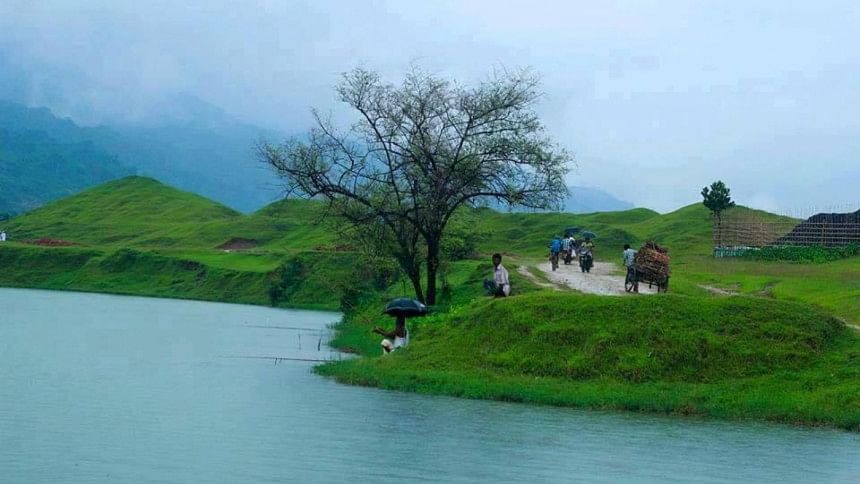Haor development: From trade-offs to eco-friendly solutions

The ecosystem of the haors and wetlands in the northeast region of Bangladesh—including the districts of Sunamganj, Sylhet, Habiganj, Moulvibazar, Netrokona, Kishoreganj and Brahmanbaria—plays a vital role in ensuring our food and nutrition security and preserving the environmental balance of the country. There are a total 373 haor wetlands there that cover approximately 43 percent of the total area of the seven haor districts. The region is well known for its beauty and natural resources.
However, it is mostly populated by poor, disadvantaged and vulnerable groups of people living in flood-prone areas, and lacking access to basic services including education, employment opportunities and decent living standards. Road connectivity along with the transportation system is a serious concern here. In Sunamganj, for instance, there is no road connection between the Upazilas.
From the 60's until 2008, development initiatives taken in this region followed a model of "trade-off" between development for its human inhabitants and its environmental integrity. Even then, there were hardly any visible positive outcomes in the absence of well-integrated and cohesive development work. Since the 90's, however, environmental concerns in development initiatives in this area, as elsewhere in the country and even outside, became more prominent and drew theoretical intervention. As a result, Tanguar Haor, located in the Dharmapasha and Tahirpur upazilas of Sunamganj, was declared as an ecologically critical area in 1999, and as a Ramsar site—"a wetland site designated to be of international importance under the Ramsar Convention"—in 2000. The International Union for Conservation of Nature (IUCN) got the authority to protect the Tanguar haor in 2006.
The idea of a comprehensive development framework for this haor region emerged in 2009. A 2012 study by a not-for-profit public trust under the Ministry of Water Resources, the Center for Environment and Geographic Information Services (CEGIS), for formerly Bangladesh Haor and Wetland Development Board (currently Directorate of Bangladesh Haor and Wetland Development), presented a 20-year master plan for the area. Since then, development interventions and outputs continue to be seemingly visible. Furthermore, a 2017 study by CEGIS documents an impact assessment of structural interventions in hoar ecosystem and innovations for solution.
The 2017 CEGIS study acknowledges that any wetland ecosystem is fragile and vulnerable, and haor-wetland is one of the major ecosystems of the country that necessitates a holistic eco-friendly plan for any development action to keep a harmonious relationship between humans and nature, which is also essential for the sustainability of the haor wetlands. Also, the global Sustainable Development Goals (SDGs) 2016-30 called for a departure from the "trade-off" police in development economics and instead sought "eco-friendly" solutions.
The 20-year framework plan is being implemented on a short-, medium- and long-term basis, integrating the multifaceted development interventions including flood management, environmental sustainability, crop production, fisheries and livestock, expansion of education, settlement and health facilities, road communication, navigation, water supply and sanitation, industry, afforestation, and generation of power and energy.
The planned investment portfolio includes 17 sectors: water resources, agriculture, fisheries, pearl culture, livestock, forest, education, health, transportation, housing and settlement, water supply and sanitation, industry, energy and power, mineral resources, biodiversity and wetland, tourism and social services.
An eco-friendly integrated development approach, which would recognise the importance of optimising available resources of the haor region as well as a sustainable development of the potential of the area by incorporating all relevant social, cultural and environmental aspects, is a must here.
Being a member of the community in this region, I am thankful to the government for its timely policy initiatives, but the haor people would not like to see a repeat of fragile development interventions of the past or the shadow of any corruption. There should be a zero-tolerance policy against "paper-based" development—meaning, development works that exist only in papers, with no real-life outcomes.
A traditional approach cannot encounter the problem at hand nor can it address the need for the kind of development that is needed. This requires a multifaceted development operational modality with diverse and innovative engagements and wide-ranging partnerships including government-entrepreneurial collaboration, public-private partnership, public-private-research institute partnership, GO-NGO partnership, government-university partnership, and government-media partnership. Thus, the government must encourage more innovative and proactive proposals from the parties involved—public, private, entrepreneurial, media, non-government, university, research and advocacy institutes.
Furthermore, an expert commission needs to be built along with a set of quality, performance as well as achievement indicators and timeframe-based measurement tools. Also, more focused research and evidence-based advocacy, as well as innovations and innovative proposals need to be developed.
Recently, I had a discussion with XDsocial, a knowledge-based entrepreneurial and management company, to develop a public-private-research institute/university partnership proposal focusing on social contributions in large-scale local employment opportunity generation, food and nutrition value addition, and innovative reprocessed energy creation for the community. More such initiatives are needed. Such people-centric as well as eco-friendly creative thinking and proposals need to be continually appreciated and supported by the government.
Certainly, the people are the ends and means of any development initiative, and eco-friendly solutions are needed for sustainable development. We do not want mindless development in the haor region. The development must be eco-friendly so that it will have no adverse effect on the future generation and indeed the vital ecosystem of this region.
Mohammad Rafiqul Islam Talukdar is a researcher on governance, development and political economy, as well as Associate Professor (Government and Politics) and Director (Research) at Asian University of Bangladesh.
Email: [email protected]





Comments